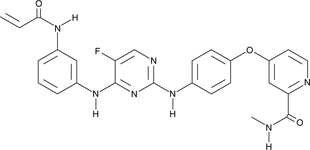Chemicals
Showing 15151–15300 of 41137 results
-
Clotrimazole is an imidazole antifungal that is active against a wide variety of fungal forms and is effective in many types of fungal infections.{25589,25585,25586,25584} It tightly binds sterol 14-α demethylase isoform B from A. fumigatus (KD = 103 nM) and, like other imidazoles, disturbs the fungal cell membrane.{25587,25584} In mammalian cells, clotrimazole potently inhibits the calcium-dependent potassium channels Kv1.3 and IK-1 (IC50 = 6.0 and 0.07 µM, respectively).{25588}
Brand:CaymanSKU:-Clotrimazole is an imidazole antifungal that is active against a wide variety of fungal forms and is effective in many types of fungal infections.{25589,25585,25586,25584} It tightly binds sterol 14-α demethylase isoform B from A. fumigatus (KD = 103 nM) and, like other imidazoles, disturbs the fungal cell membrane.{25587,25584} In mammalian cells, clotrimazole potently inhibits the calcium-dependent potassium channels Kv1.3 and IK-1 (IC50 = 6.0 and 0.07 µM, respectively).{25588}
Brand:CaymanSKU:-Clotrimazole-d5 is intended for use as an internal standard for the quantification of clotrimazole (Item No. 15278) by GC- or LC-MS. Clotrimazole is an imidazole antifungal agent.{25589} It is active against a variety of fungi, including C. albicans, A. fumigatus, S. cerevisiae, C. neoformans, T. mentagrophytes, and M. canis (MICs = v1.3 and the intermediate conductance calcium-activated potassium channel (IKCa1/KCa3.1; IC50s = 6 and 0.07 µM, respectively) and decreases proliferation of HaCaT keratinocytes (EC50 = 15 µM).{25588} Topical application of clotrimazole (1%) reduces oxazolone-induced ear swelling in an oxazolone-sensitized mouse model of delayed-type hypersensitivity. Clotrimazole (10 µM) also inhibits proliferation of A549 lung, HT-29 colon, and MM-RU melanoma cancer cells.{53795} Formulations containing clotrimazole have been used in the treatment of fungal skin infections.
Brand:CaymanSKU:30717 - 1 mgAvailable on backorder
Cloxacillin is a β-lactam antibiotic and a derivative of oxacillin (Item No. 23954).{52188} It is active against clinical isolates of the Gram-positive bacteria S. aureus and S. epidermidis (MICs = 0.004-0.4 and 0.1-0.8 µg/ml, respectively) but not 34 Gram-negative bacteria (MICs = >128 µg/ml for all).{52188,39101} Cloxacillin binds to S. aureus penicillin-binding protein 1 (PBP1), PBP2, PBP3, and PBP4 (IC50s = 0.04, 0.12, 0.21, and 2.5 µg/ml, respectively).{52189} It also binds to recombinant type Ib penicillinase, as well as P. vulgaris and C. freundii cephalosporinase (Kis = 15, 0.27, and 0.027 µM, respectively).{39103} Cloxacillin decreases the number of staphylococci in the mammary gland in a mouse model of acute, but not chronic, mastitis induced by Staphylococcus infection.{52190}
Brand:CaymanSKU:22249 -Out of stock
Cloxacillin is a β-lactam antibiotic and a derivative of oxacillin (Item No. 23954).{52188} It is active against clinical isolates of the Gram-positive bacteria S. aureus and S. epidermidis (MICs = 0.004-0.4 and 0.1-0.8 µg/ml, respectively) but not 34 Gram-negative bacteria (MICs = >128 µg/ml for all).{52188,39101} Cloxacillin binds to S. aureus penicillin-binding protein 1 (PBP1), PBP2, PBP3, and PBP4 (IC50s = 0.04, 0.12, 0.21, and 2.5 µg/ml, respectively).{52189} It also binds to recombinant type Ib penicillinase, as well as P. vulgaris and C. freundii cephalosporinase (Kis = 15, 0.27, and 0.027 µM, respectively).{39103} Cloxacillin decreases the number of staphylococci in the mammary gland in a mouse model of acute, but not chronic, mastitis induced by Staphylococcus infection.{52190}
Brand:CaymanSKU:22249 -Out of stock
Cloxacillin is a β-lactam antibiotic and a derivative of oxacillin (Item No. 23954).{52188} It is active against clinical isolates of the Gram-positive bacteria S. aureus and S. epidermidis (MICs = 0.004-0.4 and 0.1-0.8 µg/ml, respectively) but not 34 Gram-negative bacteria (MICs = >128 µg/ml for all).{52188,39101} Cloxacillin binds to S. aureus penicillin-binding protein 1 (PBP1), PBP2, PBP3, and PBP4 (IC50s = 0.04, 0.12, 0.21, and 2.5 µg/ml, respectively).{52189} It also binds to recombinant type Ib penicillinase, as well as P. vulgaris and C. freundii cephalosporinase (Kis = 15, 0.27, and 0.027 µM, respectively).{39103} Cloxacillin decreases the number of staphylococci in the mammary gland in a mouse model of acute, but not chronic, mastitis induced by Staphylococcus infection.{52190}
Brand:CaymanSKU:22249 -Out of stock
Clozapine is a partial agonist at the serotonin (5-HT) receptor subtype 5-HT1A (Ki = 180 nM).{22208,36950} It also binds to the 5-HT2A, 5-HT2C, 5-HT3, 5-HT6 and 5-HT7 receptors (Kis = 3.3, 13, 110, 4, and 21 nM, respectively), as well as the histamine H1 and α1-adrenergic receptors (Kis = 2.1 and 23 nM, respectively). It does not bind to the 5-HT1B receptor and has a lower affinity for dopamine receptors (Kis = 540, 150, and 360 nM for D1-3, respectively). Clozapine induces the release of glutamate and D-serine, an agonist at the glycine site of the NMDA receptor, from astrocytes, and reduces the expression of astrocytic glutamate transporters.{22207} It reverses locomotor hyperactivity and deficits in prepulse inhibition of acoustic startle in a rat neonatal ventral hippocampal ibotenic lesion model of schizophrenia when administered at a dose of 2.5 mg/kg per day.{39941} Formulations containing clozapine have been used in the treatment of schizophrenia.
Brand:CaymanSKU:12059 - 100 mgAvailable on backorder
Clozapine is a partial agonist at the serotonin (5-HT) receptor subtype 5-HT1A (Ki = 180 nM).{22208,36950} It also binds to the 5-HT2A, 5-HT2C, 5-HT3, 5-HT6 and 5-HT7 receptors (Kis = 3.3, 13, 110, 4, and 21 nM, respectively), as well as the histamine H1 and α1-adrenergic receptors (Kis = 2.1 and 23 nM, respectively). It does not bind to the 5-HT1B receptor and has a lower affinity for dopamine receptors (Kis = 540, 150, and 360 nM for D1-3, respectively). Clozapine induces the release of glutamate and D-serine, an agonist at the glycine site of the NMDA receptor, from astrocytes, and reduces the expression of astrocytic glutamate transporters.{22207} It reverses locomotor hyperactivity and deficits in prepulse inhibition of acoustic startle in a rat neonatal ventral hippocampal ibotenic lesion model of schizophrenia when administered at a dose of 2.5 mg/kg per day.{39941} Formulations containing clozapine have been used in the treatment of schizophrenia.
Brand:CaymanSKU:12059 - 250 mgAvailable on backorder
Clozapine is a partial agonist at the serotonin (5-HT) receptor subtype 5-HT1A (Ki = 180 nM).{22208,36950} It also binds to the 5-HT2A, 5-HT2C, 5-HT3, 5-HT6 and 5-HT7 receptors (Kis = 3.3, 13, 110, 4, and 21 nM, respectively), as well as the histamine H1 and α1-adrenergic receptors (Kis = 2.1 and 23 nM, respectively). It does not bind to the 5-HT1B receptor and has a lower affinity for dopamine receptors (Kis = 540, 150, and 360 nM for D1-3, respectively). Clozapine induces the release of glutamate and D-serine, an agonist at the glycine site of the NMDA receptor, from astrocytes, and reduces the expression of astrocytic glutamate transporters.{22207} It reverses locomotor hyperactivity and deficits in prepulse inhibition of acoustic startle in a rat neonatal ventral hippocampal ibotenic lesion model of schizophrenia when administered at a dose of 2.5 mg/kg per day.{39941} Formulations containing clozapine have been used in the treatment of schizophrenia.
Brand:CaymanSKU:12059 - 50 mgAvailable on backorder
Clozapine is a partial agonist at the serotonin (5-HT) receptor subtype 5-HT1A (Ki = 180 nM).{22208,36950} It also binds to the 5-HT2A, 5-HT2C, 5-HT3, 5-HT6 and 5-HT7 receptors (Kis = 3.3, 13, 110, 4, and 21 nM, respectively), as well as the histamine H1 and α1-adrenergic receptors (Kis = 2.1 and 23 nM, respectively). It does not bind to the 5-HT1B receptor and has a lower affinity for dopamine receptors (Kis = 540, 150, and 360 nM for D1-3, respectively). Clozapine induces the release of glutamate and D-serine, an agonist at the glycine site of the NMDA receptor, from astrocytes, and reduces the expression of astrocytic glutamate transporters.{22207} It reverses locomotor hyperactivity and deficits in prepulse inhibition of acoustic startle in a rat neonatal ventral hippocampal ibotenic lesion model of schizophrenia when administered at a dose of 2.5 mg/kg per day.{39941} Formulations containing clozapine have been used in the treatment of schizophrenia.
Brand:CaymanSKU:12059 - 500 mgAvailable on backorder
Clozapine-N-oxide is a major metabolite of clozapine (Item No. 12059) and an activator of designer receptors exclusively activated by designer drugs (DREADDs) derived from human muscarinic acetylcholine receptors (EC50s = 16.7, 323, 17.4, 18.3, and 18.7 nM for PASMCs expressing hM1-5D receptors, respectively).{27576,35354} It prevents action potential firing in cultured hippocampal neurons transiently expressing hM4D receptors.{35354} Clozapine-N-oxide increases glutamate in the nucleus accumbens core and inhibits cue-induced reinstatement of cocaine-seeking behavior in rats transfected with hM3Dq DREADD receptors.{42492}
Brand:CaymanSKU:-Out of stock
Clozapine-N-oxide is a major metabolite of clozapine (Item No. 12059) and an activator of designer receptors exclusively activated by designer drugs (DREADDs) derived from human muscarinic acetylcholine receptors (EC50s = 16.7, 323, 17.4, 18.3, and 18.7 nM for PASMCs expressing hM1-5D receptors, respectively).{27576,35354} It prevents action potential firing in cultured hippocampal neurons transiently expressing hM4D receptors.{35354} Clozapine-N-oxide increases glutamate in the nucleus accumbens core and inhibits cue-induced reinstatement of cocaine-seeking behavior in rats transfected with hM3Dq DREADD receptors.{42492}
Brand:CaymanSKU:-Out of stock
Clozapine-N-oxide is a major metabolite of clozapine (Item No. 12059) and an activator of designer receptors exclusively activated by designer drugs (DREADDs) derived from human muscarinic acetylcholine receptors (EC50s = 16.7, 323, 17.4, 18.3, and 18.7 nM for PASMCs expressing hM1-5D receptors, respectively).{27576,35354} It prevents action potential firing in cultured hippocampal neurons transiently expressing hM4D receptors.{35354} Clozapine-N-oxide increases glutamate in the nucleus accumbens core and inhibits cue-induced reinstatement of cocaine-seeking behavior in rats transfected with hM3Dq DREADD receptors.{42492}
Brand:CaymanSKU:-Out of stock
Clozapine-N-oxide is a major metabolite of clozapine (Item No. 12059) and an activator of designer receptors exclusively activated by designer drugs (DREADDs) derived from human muscarinic acetylcholine receptors (EC50s = 16.7, 323, 17.4, 18.3, and 18.7 nM for PASMCs expressing hM1-5D receptors, respectively).{27576,35354} It prevents action potential firing in cultured hippocampal neurons transiently expressing hM4D receptors.{35354} Clozapine-N-oxide increases glutamate in the nucleus accumbens core and inhibits cue-induced reinstatement of cocaine-seeking behavior in rats transfected with hM3Dq DREADD receptors.{42492}
Brand:CaymanSKU:-Out of stock
Clozapine-d4 is intended for use as an internal standard for the quantification of clozapine (Item Nos. 12059 | 25779) by GC- or LC-MS. Clozapine is a partial agonist at the serotonin (5-HT) receptor subtype 5-HT1A (Ki = 180 nM).{22208,36950} It also binds to 5-HT2A, 5-HT2C, 5-HT3, 5-HT6 and 5-HT7 receptors (Kis = 3.3, 13, 110, 4, and 21 nM, respectively), as well as the histamine H1 and α1-adrenergic receptors (Kis = 2.1 and 23 nM, respectively). It does not bind to the 5-HT1B receptor and has a lower affinity for dopamine receptors (Kis = 540, 150, and 360 nM for D1-3, respectively). Clozapine induces the release of glutamate and D-serine, an agonist at the glycine site of the NMDA receptor, from astrocytes, and reduces the expression of astrocytic glutamate transporters.{22207} It reverses locomotor hyperactivity and deficits in prepulse inhibition of acoustic startle in a rat neonatal ventral hippocampal ibotenic lesion model of schizophrenia when administered at a dose of 2.5 mg/kg per day.{39941} Formulations containing clozapine have been used in the treatment of schizophrenia.
Brand:CaymanSKU:-Available on backorder
Clozapine-d4 is intended for use as an internal standard for the quantification of clozapine (Item Nos. 12059 | 25779) by GC- or LC-MS. Clozapine is a partial agonist at the serotonin (5-HT) receptor subtype 5-HT1A (Ki = 180 nM).{22208,36950} It also binds to 5-HT2A, 5-HT2C, 5-HT3, 5-HT6 and 5-HT7 receptors (Kis = 3.3, 13, 110, 4, and 21 nM, respectively), as well as the histamine H1 and α1-adrenergic receptors (Kis = 2.1 and 23 nM, respectively). It does not bind to the 5-HT1B receptor and has a lower affinity for dopamine receptors (Kis = 540, 150, and 360 nM for D1-3, respectively). Clozapine induces the release of glutamate and D-serine, an agonist at the glycine site of the NMDA receptor, from astrocytes, and reduces the expression of astrocytic glutamate transporters.{22207} It reverses locomotor hyperactivity and deficits in prepulse inhibition of acoustic startle in a rat neonatal ventral hippocampal ibotenic lesion model of schizophrenia when administered at a dose of 2.5 mg/kg per day.{39941} Formulations containing clozapine have been used in the treatment of schizophrenia.
Brand:CaymanSKU:-Available on backorder
Clozapine-d4 is intended for use as an internal standard for the quantification of clozapine (Item Nos. 12059 | 25779) by GC- or LC-MS. Clozapine is a partial agonist at the serotonin (5-HT) receptor subtype 5-HT1A (Ki = 180 nM).{22208,36950} It also binds to 5-HT2A, 5-HT2C, 5-HT3, 5-HT6 and 5-HT7 receptors (Kis = 3.3, 13, 110, 4, and 21 nM, respectively), as well as the histamine H1 and α1-adrenergic receptors (Kis = 2.1 and 23 nM, respectively). It does not bind to the 5-HT1B receptor and has a lower affinity for dopamine receptors (Kis = 540, 150, and 360 nM for D1-3, respectively). Clozapine induces the release of glutamate and D-serine, an agonist at the glycine site of the NMDA receptor, from astrocytes, and reduces the expression of astrocytic glutamate transporters.{22207} It reverses locomotor hyperactivity and deficits in prepulse inhibition of acoustic startle in a rat neonatal ventral hippocampal ibotenic lesion model of schizophrenia when administered at a dose of 2.5 mg/kg per day.{39941} Formulations containing clozapine have been used in the treatment of schizophrenia.
Brand:CaymanSKU:-Available on backorder
CLP 257 is a K+/Cl- cotransporter 2 (KCC2) activator.{57069,57070,57071} It induces chloride transport in NG108-cl cells that endogenously express low levels of KCC2 (EC50 = 616 nM).{57069} It is selective for KCC2 over GABAA receptors at 50 µM. CLP 257 (25 µM) increases the rate of chloride accumulation in spinal slices isolated from a rat model of peripheral nerve injury and BDNF control slices, which exhibit reduced levels of KCC2. In vivo, CLP 257 (100 mg/kg) increases mechanical and withdrawal thresholds in a rat model of peripheral nerve injury and reverses morphine-induced hyperalgesia in rats.{57069,57072}
Brand:CaymanSKU:30948 - 1 mgAvailable on backorder
CLP 257 is a K+/Cl- cotransporter 2 (KCC2) activator.{57069,57070,57071} It induces chloride transport in NG108-cl cells that endogenously express low levels of KCC2 (EC50 = 616 nM).{57069} It is selective for KCC2 over GABAA receptors at 50 µM. CLP 257 (25 µM) increases the rate of chloride accumulation in spinal slices isolated from a rat model of peripheral nerve injury and BDNF control slices, which exhibit reduced levels of KCC2. In vivo, CLP 257 (100 mg/kg) increases mechanical and withdrawal thresholds in a rat model of peripheral nerve injury and reverses morphine-induced hyperalgesia in rats.{57069,57072}
Brand:CaymanSKU:30948 - 10 mgAvailable on backorder
CLP 257 is a K+/Cl- cotransporter 2 (KCC2) activator.{57069,57070,57071} It induces chloride transport in NG108-cl cells that endogenously express low levels of KCC2 (EC50 = 616 nM).{57069} It is selective for KCC2 over GABAA receptors at 50 µM. CLP 257 (25 µM) increases the rate of chloride accumulation in spinal slices isolated from a rat model of peripheral nerve injury and BDNF control slices, which exhibit reduced levels of KCC2. In vivo, CLP 257 (100 mg/kg) increases mechanical and withdrawal thresholds in a rat model of peripheral nerve injury and reverses morphine-induced hyperalgesia in rats.{57069,57072}
Brand:CaymanSKU:30948 - 5 mgAvailable on backorder
CLP 290 is a carbamate prodrug form of the K+/Cl- cotransporter 2 (KCC2) activator CLP 257 (Item No. 30948).{57069} It increases the mechanical paw withdrawal threshold in a rat model of peripheral nerve injury and reverses morphine-induced hyperalgesia in rats when administered at a dose of 100 mg/kg.{57069,57072} CLP 290 (35 mg/kg) also restores stepping ability, as well as increases body weight support and stride length, in a mouse model of paralysis induced by staggered spinal lesions.{57226}
Brand:CaymanSKU:31448 - 1 mgAvailable on backorder
CLP 290 is a carbamate prodrug form of the K+/Cl- cotransporter 2 (KCC2) activator CLP 257 (Item No. 30948).{57069} It increases the mechanical paw withdrawal threshold in a rat model of peripheral nerve injury and reverses morphine-induced hyperalgesia in rats when administered at a dose of 100 mg/kg.{57069,57072} CLP 290 (35 mg/kg) also restores stepping ability, as well as increases body weight support and stride length, in a mouse model of paralysis induced by staggered spinal lesions.{57226}
Brand:CaymanSKU:31448 - 10 mgAvailable on backorder
CLP 290 is a carbamate prodrug form of the K+/Cl- cotransporter 2 (KCC2) activator CLP 257 (Item No. 30948).{57069} It increases the mechanical paw withdrawal threshold in a rat model of peripheral nerve injury and reverses morphine-induced hyperalgesia in rats when administered at a dose of 100 mg/kg.{57069,57072} CLP 290 (35 mg/kg) also restores stepping ability, as well as increases body weight support and stride length, in a mouse model of paralysis induced by staggered spinal lesions.{57226}
Brand:CaymanSKU:31448 - 25 mgAvailable on backorder
CLP 290 is a carbamate prodrug form of the K+/Cl- cotransporter 2 (KCC2) activator CLP 257 (Item No. 30948).{57069} It increases the mechanical paw withdrawal threshold in a rat model of peripheral nerve injury and reverses morphine-induced hyperalgesia in rats when administered at a dose of 100 mg/kg.{57069,57072} CLP 290 (35 mg/kg) also restores stepping ability, as well as increases body weight support and stride length, in a mouse model of paralysis induced by staggered spinal lesions.{57226}
Brand:CaymanSKU:31448 - 5 mgAvailable on backorder
CM037 is a selective inhibitor of aldehyde dehydrogenase 1A1 (ALDH1A1; IC50 = 4.6 µM).{40439} It is selective for ALDH1A1 over eight other ALDH isoenzymes at a concentration of 20 µM. CM037 is a competitive inhibitor against acetaldehyde with a Ki value of 0.23 µM.
Brand:CaymanSKU:21868 -Out of stock
CM037 is a selective inhibitor of aldehyde dehydrogenase 1A1 (ALDH1A1; IC50 = 4.6 µM).{40439} It is selective for ALDH1A1 over eight other ALDH isoenzymes at a concentration of 20 µM. CM037 is a competitive inhibitor against acetaldehyde with a Ki value of 0.23 µM.
Brand:CaymanSKU:21868 -Out of stock
CM037 is a selective inhibitor of aldehyde dehydrogenase 1A1 (ALDH1A1; IC50 = 4.6 µM).{40439} It is selective for ALDH1A1 over eight other ALDH isoenzymes at a concentration of 20 µM. CM037 is a competitive inhibitor against acetaldehyde with a Ki value of 0.23 µM.
Brand:CaymanSKU:21868 -Out of stock
CM037 is a selective inhibitor of aldehyde dehydrogenase 1A1 (ALDH1A1; IC50 = 4.6 µM).{40439} It is selective for ALDH1A1 over eight other ALDH isoenzymes at a concentration of 20 µM. CM037 is a competitive inhibitor against acetaldehyde with a Ki value of 0.23 µM.
Brand:CaymanSKU:21868 -Out of stock
CMP-Sialic acid is a form of the sugar N-acetylneuraminic acid (Neu5Ac) O-linked with the nucleotide cytidine-5’-monophosphate (CMP). In vertebrates, it is biosynthesized within the nucleus from CTP and Neu5Ac by CMP-sialic acid synthetases.{26786} Sialyltransferases transfer Neu5Ac from CMP-sialic acid to various acceptor substrates, most commonly at terminal positions of the oligosaccharide component of glycoproteins or glycolipids.{26788,26784} Sialic acid-containing glycans at the cell surface play important roles in cell interactions and have roles in infection, inflammation, and cancer.{26784,26785,26787}
Brand:CaymanSKU:-Out of stock
CMP-Sialic acid is a form of the sugar N-acetylneuraminic acid (Neu5Ac) O-linked with the nucleotide cytidine-5’-monophosphate (CMP). In vertebrates, it is biosynthesized within the nucleus from CTP and Neu5Ac by CMP-sialic acid synthetases.{26786} Sialyltransferases transfer Neu5Ac from CMP-sialic acid to various acceptor substrates, most commonly at terminal positions of the oligosaccharide component of glycoproteins or glycolipids.{26788,26784} Sialic acid-containing glycans at the cell surface play important roles in cell interactions and have roles in infection, inflammation, and cancer.{26784,26785,26787}
Brand:CaymanSKU:-Out of stock
CMP-Sialic acid is a form of the sugar N-acetylneuraminic acid (Neu5Ac) O-linked with the nucleotide cytidine-5’-monophosphate (CMP). In vertebrates, it is biosynthesized within the nucleus from CTP and Neu5Ac by CMP-sialic acid synthetases.{26786} Sialyltransferases transfer Neu5Ac from CMP-sialic acid to various acceptor substrates, most commonly at terminal positions of the oligosaccharide component of glycoproteins or glycolipids.{26788,26784} Sialic acid-containing glycans at the cell surface play important roles in cell interactions and have roles in infection, inflammation, and cancer.{26784,26785,26787}
Brand:CaymanSKU:-Out of stock
CMP-Sialic acid is a form of the sugar N-acetylneuraminic acid (Neu5Ac) O-linked with the nucleotide cytidine-5’-monophosphate (CMP). In vertebrates, it is biosynthesized within the nucleus from CTP and Neu5Ac by CMP-sialic acid synthetases.{26786} Sialyltransferases transfer Neu5Ac from CMP-sialic acid to various acceptor substrates, most commonly at terminal positions of the oligosaccharide component of glycoproteins or glycolipids.{26788,26784} Sialic acid-containing glycans at the cell surface play important roles in cell interactions and have roles in infection, inflammation, and cancer.{26784,26785,26787}
Brand:CaymanSKU:-Out of stock
CMPD101 is an inhibitor of G protein-coupled receptor kinase 2 (GRK2) and GRK3 (IC50s = 18 and 5.4 nM, respectively).{42803} It is selective for GRK2 and GRK3 over GRK1, GRK5, GRK6, and GRK7 (IC50s = 3,100, 2,300, >30,000, and 25,000 nM, respectively), as well as Rho-associated kinase 2 (ROCK-2) and PKCα (IC50s = 1,400 and 8,100 nM, respectively). CMPD101 induces cAMP accumulation in HEK293 cells expressing human β2-adrenergic receptors (EC50 = 10 µM). In isolated human prostate strips, CMPD101 (50 µM) inhibits contractions induced by electrical field stimulation, norepinephrine, phenylephrine, endothelin-1 (Item No. 24127), and U-46619 (Item No. 16450).{42804}
Brand:CaymanSKU:26808 - 1 mgAvailable on backorder
CMPD101 is an inhibitor of G protein-coupled receptor kinase 2 (GRK2) and GRK3 (IC50s = 18 and 5.4 nM, respectively).{42803} It is selective for GRK2 and GRK3 over GRK1, GRK5, GRK6, and GRK7 (IC50s = 3,100, 2,300, >30,000, and 25,000 nM, respectively), as well as Rho-associated kinase 2 (ROCK-2) and PKCα (IC50s = 1,400 and 8,100 nM, respectively). CMPD101 induces cAMP accumulation in HEK293 cells expressing human β2-adrenergic receptors (EC50 = 10 µM). In isolated human prostate strips, CMPD101 (50 µM) inhibits contractions induced by electrical field stimulation, norepinephrine, phenylephrine, endothelin-1 (Item No. 24127), and U-46619 (Item No. 16450).{42804}
Brand:CaymanSKU:26808 - 10 mgAvailable on backorder
CMPD101 is an inhibitor of G protein-coupled receptor kinase 2 (GRK2) and GRK3 (IC50s = 18 and 5.4 nM, respectively).{42803} It is selective for GRK2 and GRK3 over GRK1, GRK5, GRK6, and GRK7 (IC50s = 3,100, 2,300, >30,000, and 25,000 nM, respectively), as well as Rho-associated kinase 2 (ROCK-2) and PKCα (IC50s = 1,400 and 8,100 nM, respectively). CMPD101 induces cAMP accumulation in HEK293 cells expressing human β2-adrenergic receptors (EC50 = 10 µM). In isolated human prostate strips, CMPD101 (50 µM) inhibits contractions induced by electrical field stimulation, norepinephrine, phenylephrine, endothelin-1 (Item No. 24127), and U-46619 (Item No. 16450).{42804}
Brand:CaymanSKU:26808 - 25 mgAvailable on backorder
CMPD101 is an inhibitor of G protein-coupled receptor kinase 2 (GRK2) and GRK3 (IC50s = 18 and 5.4 nM, respectively).{42803} It is selective for GRK2 and GRK3 over GRK1, GRK5, GRK6, and GRK7 (IC50s = 3,100, 2,300, >30,000, and 25,000 nM, respectively), as well as Rho-associated kinase 2 (ROCK-2) and PKCα (IC50s = 1,400 and 8,100 nM, respectively). CMPD101 induces cAMP accumulation in HEK293 cells expressing human β2-adrenergic receptors (EC50 = 10 µM). In isolated human prostate strips, CMPD101 (50 µM) inhibits contractions induced by electrical field stimulation, norepinephrine, phenylephrine, endothelin-1 (Item No. 24127), and U-46619 (Item No. 16450).{42804}
Brand:CaymanSKU:26808 - 5 mgAvailable on backorder
CMPDA is a positive allosteric modulator of the ionotropic glutamate receptor GluA2.{49253} It increases glutamate-induced calcium influx into HEK293 cells expressing human GluA2i or GluA2o receptors (EC50s = 45.4 and 63.4 nM, respectively). CMPDA (10 μM) inhibits desensitization of rat GluA2o and GluA2i receptors, as well as slows the rate of deactivation of GluA2o, but not GluA2i, receptors, in HEK293 cells.
Brand:CaymanSKU:-CMPDA is a positive allosteric modulator of the ionotropic glutamate receptor GluA2.{49253} It increases glutamate-induced calcium influx into HEK293 cells expressing human GluA2i or GluA2o receptors (EC50s = 45.4 and 63.4 nM, respectively). CMPDA (10 μM) inhibits desensitization of rat GluA2o and GluA2i receptors, as well as slows the rate of deactivation of GluA2o, but not GluA2i, receptors, in HEK293 cells.
Brand:CaymanSKU:-CMPDA is a positive allosteric modulator of the ionotropic glutamate receptor GluA2.{49253} It increases glutamate-induced calcium influx into HEK293 cells expressing human GluA2i or GluA2o receptors (EC50s = 45.4 and 63.4 nM, respectively). CMPDA (10 μM) inhibits desensitization of rat GluA2o and GluA2i receptors, as well as slows the rate of deactivation of GluA2o, but not GluA2i, receptors, in HEK293 cells.
Brand:CaymanSKU:-CMPDA is a positive allosteric modulator of the ionotropic glutamate receptor GluA2.{49253} It increases glutamate-induced calcium influx into HEK293 cells expressing human GluA2i or GluA2o receptors (EC50s = 45.4 and 63.4 nM, respectively). CMPDA (10 μM) inhibits desensitization of rat GluA2o and GluA2i receptors, as well as slows the rate of deactivation of GluA2o, but not GluA2i, receptors, in HEK293 cells.
Brand:CaymanSKU:-Furan fatty acids are unique, naturally occurring lipids that are found in significant amounts in dietary phospholipids, such as in salmon roe.{13184} CMPF is an endogenous metabolite of furan fatty acids in humans. CMPF is highly albumin-bound and accumulates in the serum of uremic patients to concentrations in excess of 0.2 mM. Its primary effect is to inhibit cellular transport and subsequent deiodination of thyroxine (T4).{13104,13105} CMPF is tightly bound to albumin but only moderately inhibits T4 binding in a direct manner (10-14% at 0.3 mM). However, CMPF effectively displaces competitive T4 binding molecules from albumin, such as acidic drugs and free fatty acids.{13105} Therefore, CMPF may indirectly influence T4 binding to albumin by increasing the serum concentration of competitive binding molecules, particularly free fatty acids such as oleic acid.{13105}
Brand:CaymanSKU:10007133 - 1 mgAvailable on backorder
Furan fatty acids are unique, naturally occurring lipids that are found in significant amounts in dietary phospholipids, such as in salmon roe.{13184} CMPF is an endogenous metabolite of furan fatty acids in humans. CMPF is highly albumin-bound and accumulates in the serum of uremic patients to concentrations in excess of 0.2 mM. Its primary effect is to inhibit cellular transport and subsequent deiodination of thyroxine (T4).{13104,13105} CMPF is tightly bound to albumin but only moderately inhibits T4 binding in a direct manner (10-14% at 0.3 mM). However, CMPF effectively displaces competitive T4 binding molecules from albumin, such as acidic drugs and free fatty acids.{13105} Therefore, CMPF may indirectly influence T4 binding to albumin by increasing the serum concentration of competitive binding molecules, particularly free fatty acids such as oleic acid.{13105}
Brand:CaymanSKU:10007133 - 10 mgAvailable on backorder
Furan fatty acids are unique, naturally occurring lipids that are found in significant amounts in dietary phospholipids, such as in salmon roe.{13184} CMPF is an endogenous metabolite of furan fatty acids in humans. CMPF is highly albumin-bound and accumulates in the serum of uremic patients to concentrations in excess of 0.2 mM. Its primary effect is to inhibit cellular transport and subsequent deiodination of thyroxine (T4).{13104,13105} CMPF is tightly bound to albumin but only moderately inhibits T4 binding in a direct manner (10-14% at 0.3 mM). However, CMPF effectively displaces competitive T4 binding molecules from albumin, such as acidic drugs and free fatty acids.{13105} Therefore, CMPF may indirectly influence T4 binding to albumin by increasing the serum concentration of competitive binding molecules, particularly free fatty acids such as oleic acid.{13105}
Brand:CaymanSKU:10007133 - 5 mgAvailable on backorder
Furan fatty acids are unique, naturally occurring lipids that are found in significant amounts in dietary phospholipids, such as in salmon roe.{13184} CMPF is an endogenous metabolite of furan fatty acids in humans. CMPF is highly albumin-bound and accumulates in the serum of uremic patients to concentrations in excess of 0.2 mM. Its primary effect is to inhibit cellular transport and subsequent deiodination of thyroxine (T4).{13104,13105} CMPF is tightly bound to albumin but only moderately inhibits T4 binding in a direct manner (10-14% at 0.3 mM). However, CMPF effectively displaces competitive T4 binding molecules from albumin, such as acidic drugs and free fatty acids.{13105} Therefore, CMPF may indirectly influence T4 binding to albumin by increasing the serum concentration of competitive binding molecules, particularly free fatty acids such as oleic acid.{13105}
Brand:CaymanSKU:10007133 - 500 µgAvailable on backorder
CMS121 is a substituted quinoline that has neuroprotective, anti-inflammatory, antioxidative, and renoprotective activities.{47397,47398,47400} It maintains glutathione (GSH) levels in HT22 mouse hippocampal cells in vitro in the presence of glutamate, induces differentiation of PC12 cells, prevents LPS-induced N9 microglial activation by 82% in N9 microglia, and scavenges free radicals in a Trolox equivalent activity concentration (TEAC) assay.{47397} CMS121 protects against ischemia and oxytosis in phenotypic screens in HT22 cells in vitro with EC50 values of 7 and 200 nM for preventing iodoacetic acid- or glutamate-induced cell death, respectively.{47398} It is also renoprotective, decreasing kidney weight loss and decreasing the expression of TNF-α, caspase-1, and inducible nitric oxide synthase (iNOS) in a SAMP8 mouse model of chronic kidney disease associated with rapid aging when administered at a dose of 10 mg/kg per day starting at nine months of age.{47400}
Brand:CaymanSKU:27085 - 1 mgAvailable on backorder
CMS121 is a substituted quinoline that has neuroprotective, anti-inflammatory, antioxidative, and renoprotective activities.{47397,47398,47400} It maintains glutathione (GSH) levels in HT22 mouse hippocampal cells in vitro in the presence of glutamate, induces differentiation of PC12 cells, prevents LPS-induced N9 microglial activation by 82% in N9 microglia, and scavenges free radicals in a Trolox equivalent activity concentration (TEAC) assay.{47397} CMS121 protects against ischemia and oxytosis in phenotypic screens in HT22 cells in vitro with EC50 values of 7 and 200 nM for preventing iodoacetic acid- or glutamate-induced cell death, respectively.{47398} It is also renoprotective, decreasing kidney weight loss and decreasing the expression of TNF-α, caspase-1, and inducible nitric oxide synthase (iNOS) in a SAMP8 mouse model of chronic kidney disease associated with rapid aging when administered at a dose of 10 mg/kg per day starting at nine months of age.{47400}
Brand:CaymanSKU:27085 - 10 mgAvailable on backorder
CMS121 is a substituted quinoline that has neuroprotective, anti-inflammatory, antioxidative, and renoprotective activities.{47397,47398,47400} It maintains glutathione (GSH) levels in HT22 mouse hippocampal cells in vitro in the presence of glutamate, induces differentiation of PC12 cells, prevents LPS-induced N9 microglial activation by 82% in N9 microglia, and scavenges free radicals in a Trolox equivalent activity concentration (TEAC) assay.{47397} CMS121 protects against ischemia and oxytosis in phenotypic screens in HT22 cells in vitro with EC50 values of 7 and 200 nM for preventing iodoacetic acid- or glutamate-induced cell death, respectively.{47398} It is also renoprotective, decreasing kidney weight loss and decreasing the expression of TNF-α, caspase-1, and inducible nitric oxide synthase (iNOS) in a SAMP8 mouse model of chronic kidney disease associated with rapid aging when administered at a dose of 10 mg/kg per day starting at nine months of age.{47400}
Brand:CaymanSKU:27085 - 25 mgAvailable on backorder
CMS121 is a substituted quinoline that has neuroprotective, anti-inflammatory, antioxidative, and renoprotective activities.{47397,47398,47400} It maintains glutathione (GSH) levels in HT22 mouse hippocampal cells in vitro in the presence of glutamate, induces differentiation of PC12 cells, prevents LPS-induced N9 microglial activation by 82% in N9 microglia, and scavenges free radicals in a Trolox equivalent activity concentration (TEAC) assay.{47397} CMS121 protects against ischemia and oxytosis in phenotypic screens in HT22 cells in vitro with EC50 values of 7 and 200 nM for preventing iodoacetic acid- or glutamate-induced cell death, respectively.{47398} It is also renoprotective, decreasing kidney weight loss and decreasing the expression of TNF-α, caspase-1, and inducible nitric oxide synthase (iNOS) in a SAMP8 mouse model of chronic kidney disease associated with rapid aging when administered at a dose of 10 mg/kg per day starting at nine months of age.{47400}
Brand:CaymanSKU:27085 - 5 mgAvailable on backorder
CNQX is a competitive, non-NMDA glutamate receptor antagonist (IC50s = 0.3 and 1.5 μM for AMPA and kainate receptors, respectively, versus IC50 = 25 μM for NMDA receptors).{23071,23072} This compound has been used to specifically target AMPA and kainate receptor responses and thus differentiate from that of NMDA receptors.
Brand:CaymanSKU:-CNQX is a competitive, non-NMDA glutamate receptor antagonist (IC50s = 0.3 and 1.5 μM for AMPA and kainate receptors, respectively, versus IC50 = 25 μM for NMDA receptors).{23071,23072} This compound has been used to specifically target AMPA and kainate receptor responses and thus differentiate from that of NMDA receptors.
Brand:CaymanSKU:-CNQX is a competitive, non-NMDA glutamate receptor antagonist (IC50s = 0.3 and 1.5 μM for AMPA and kainate receptors, respectively, versus IC50 = 25 μM for NMDA receptors).{23071,23072} This compound has been used to specifically target AMPA and kainate receptor responses and thus differentiate from that of NMDA receptors.
Brand:CaymanSKU:-CNQX is a competitive, non-NMDA glutamate receptor antagonist (IC50s = 0.3 and 1.5 μM for AMPA and kainate receptors, respectively, versus IC50 = 25 μM for NMDA receptors).{23071,23072} This compound has been used to specifically target AMPA and kainate receptor responses and thus differentiate from that of NMDA receptors.
Brand:CaymanSKU:-CNX-1351 is a covalent inhibitor of PI3Kα (IC50 = 6.8 nM).{56002} It is selective for PI3Kα over PI3Kβ, -γ, and -δ (IC50s = 166, 240.3, and 3,020 nM, respectively), as well as PI3KC2A, PI3KC, PI4Kα, PI4Kβ, SPHK1, and SPHK2 (IC50s = >1 µM for all). CNX-1351 (500 nM) inhibits phosphorylation of Akt in SKOV3 cells. It inhibits the growth of SKOV3 and MCF-7 cancer cells (GI50s = 77.6 and 54.7 nM, respectively). CNX-1351 (100 mg/kg) inhibits Akt phosphorylation in mouse spleen.
Brand:CaymanSKU:30264 - 1 mgAvailable on backorder
CNX-1351 is a covalent inhibitor of PI3Kα (IC50 = 6.8 nM).{56002} It is selective for PI3Kα over PI3Kβ, -γ, and -δ (IC50s = 166, 240.3, and 3,020 nM, respectively), as well as PI3KC2A, PI3KC, PI4Kα, PI4Kβ, SPHK1, and SPHK2 (IC50s = >1 µM for all). CNX-1351 (500 nM) inhibits phosphorylation of Akt in SKOV3 cells. It inhibits the growth of SKOV3 and MCF-7 cancer cells (GI50s = 77.6 and 54.7 nM, respectively). CNX-1351 (100 mg/kg) inhibits Akt phosphorylation in mouse spleen.
Brand:CaymanSKU:30264 - 10 mgAvailable on backorder
CNX-1351 is a covalent inhibitor of PI3Kα (IC50 = 6.8 nM).{56002} It is selective for PI3Kα over PI3Kβ, -γ, and -δ (IC50s = 166, 240.3, and 3,020 nM, respectively), as well as PI3KC2A, PI3KC, PI4Kα, PI4Kβ, SPHK1, and SPHK2 (IC50s = >1 µM for all). CNX-1351 (500 nM) inhibits phosphorylation of Akt in SKOV3 cells. It inhibits the growth of SKOV3 and MCF-7 cancer cells (GI50s = 77.6 and 54.7 nM, respectively). CNX-1351 (100 mg/kg) inhibits Akt phosphorylation in mouse spleen.
Brand:CaymanSKU:30264 - 25 mgAvailable on backorder
CNX-1351 is a covalent inhibitor of PI3Kα (IC50 = 6.8 nM).{56002} It is selective for PI3Kα over PI3Kβ, -γ, and -δ (IC50s = 166, 240.3, and 3,020 nM, respectively), as well as PI3KC2A, PI3KC, PI4Kα, PI4Kβ, SPHK1, and SPHK2 (IC50s = >1 µM for all). CNX-1351 (500 nM) inhibits phosphorylation of Akt in SKOV3 cells. It inhibits the growth of SKOV3 and MCF-7 cancer cells (GI50s = 77.6 and 54.7 nM, respectively). CNX-1351 (100 mg/kg) inhibits Akt phosphorylation in mouse spleen.
Brand:CaymanSKU:30264 - 5 mgAvailable on backorder
CNX-2006 is an irreversible inhibitor of mutant EGFRs.{54404} It inhibits EGFR phosphorylation in PC-9 and HCC827 cells (IC50s = 55-104 nM), which express the EGFRDel E746_A750 mutation, and NCI H1975 and PC-9/GR4 cells (IC50s = 46 and 61 nM, respectively), which express the EGFRL858R/T790M and EGFRDel E746_A750/T790M mutations, respectively. It is greater than 10-fold selective for cells expressing these mutants over A549 cells expressing wild-type EGFR. CNX-2006 inhibits growth in a panel of non-small cell lung cancer (NSCLC) cells expressing wild-type or mutant EGFRs (GI50s = 0.34-8 and 0.003-3.6 μM, respectively). It reduces tumor growth in an NCI H1975 mouse xenograft model when administered at doses of 25 and 50 mg/kg.
Brand:CaymanSKU:30610 - 1 mgAvailable on backorder
CNX-2006 is an irreversible inhibitor of mutant EGFRs.{54404} It inhibits EGFR phosphorylation in PC-9 and HCC827 cells (IC50s = 55-104 nM), which express the EGFRDel E746_A750 mutation, and NCI H1975 and PC-9/GR4 cells (IC50s = 46 and 61 nM, respectively), which express the EGFRL858R/T790M and EGFRDel E746_A750/T790M mutations, respectively. It is greater than 10-fold selective for cells expressing these mutants over A549 cells expressing wild-type EGFR. CNX-2006 inhibits growth in a panel of non-small cell lung cancer (NSCLC) cells expressing wild-type or mutant EGFRs (GI50s = 0.34-8 and 0.003-3.6 μM, respectively). It reduces tumor growth in an NCI H1975 mouse xenograft model when administered at doses of 25 and 50 mg/kg.
Brand:CaymanSKU:30610 - 10 mgAvailable on backorder
CNX-2006 is an irreversible inhibitor of mutant EGFRs.{54404} It inhibits EGFR phosphorylation in PC-9 and HCC827 cells (IC50s = 55-104 nM), which express the EGFRDel E746_A750 mutation, and NCI H1975 and PC-9/GR4 cells (IC50s = 46 and 61 nM, respectively), which express the EGFRL858R/T790M and EGFRDel E746_A750/T790M mutations, respectively. It is greater than 10-fold selective for cells expressing these mutants over A549 cells expressing wild-type EGFR. CNX-2006 inhibits growth in a panel of non-small cell lung cancer (NSCLC) cells expressing wild-type or mutant EGFRs (GI50s = 0.34-8 and 0.003-3.6 μM, respectively). It reduces tumor growth in an NCI H1975 mouse xenograft model when administered at doses of 25 and 50 mg/kg.
Brand:CaymanSKU:30610 - 25 mgAvailable on backorder
CNX-2006 is an irreversible inhibitor of mutant EGFRs.{54404} It inhibits EGFR phosphorylation in PC-9 and HCC827 cells (IC50s = 55-104 nM), which express the EGFRDel E746_A750 mutation, and NCI H1975 and PC-9/GR4 cells (IC50s = 46 and 61 nM, respectively), which express the EGFRL858R/T790M and EGFRDel E746_A750/T790M mutations, respectively. It is greater than 10-fold selective for cells expressing these mutants over A549 cells expressing wild-type EGFR. CNX-2006 inhibits growth in a panel of non-small cell lung cancer (NSCLC) cells expressing wild-type or mutant EGFRs (GI50s = 0.34-8 and 0.003-3.6 μM, respectively). It reduces tumor growth in an NCI H1975 mouse xenograft model when administered at doses of 25 and 50 mg/kg.
Brand:CaymanSKU:30610 - 5 mgAvailable on backorder
CNX-774 is a potent, selective, and irreversible inhibitor of Bruton’s tyrosine kinase (BTK), an important kinase in the B cell antigen receptor pathway, with IC50 values of 50 = 2.82 and 0.38 µM) but has no effect on cell cycle progression.{34333}
Brand:CaymanSKU:21475 -Out of stock
CNX-774 is a potent, selective, and irreversible inhibitor of Bruton’s tyrosine kinase (BTK), an important kinase in the B cell antigen receptor pathway, with IC50 values of 50 = 2.82 and 0.38 µM) but has no effect on cell cycle progression.{34333}
Brand:CaymanSKU:21475 -Out of stock
CNX-774 is a potent, selective, and irreversible inhibitor of Bruton’s tyrosine kinase (BTK), an important kinase in the B cell antigen receptor pathway, with IC50 values of 50 = 2.82 and 0.38 µM) but has no effect on cell cycle progression.{34333}
Brand:CaymanSKU:21475 -Out of stock
CNX-774 is a potent, selective, and irreversible inhibitor of Bruton’s tyrosine kinase (BTK), an important kinase in the B cell antigen receptor pathway, with IC50 values of 50 = 2.82 and 0.38 µM) but has no effect on cell cycle progression.{34333}
Brand:CaymanSKU:21475 -Out of stock
CO-1686 is an irreversible kinase inhibitor that specifically targets mutant forms of the epidermal growth factor receptor (EGFR) including T790M (Ki = 21.5 nM) with significantly reduced activity at the wild-type form of the receptor (Ki = 303.3 nM).{27821} CO-1686 has been shown to inhibit the proliferation of non-small cell lung cancer (NSCLC) cells expressing mutant EGFR with GI50 values ranging from 7-32 nM in vitro, inducing apoptosis.{27821} It also demonstrates anti-tumor activity in NSCLC EGFR mutant xenograft and transgenic models dosed orally at 100 mg/kg/day.{27821}
Brand:CaymanSKU:-CO-1686 is an irreversible kinase inhibitor that specifically targets mutant forms of the epidermal growth factor receptor (EGFR) including T790M (Ki = 21.5 nM) with significantly reduced activity at the wild-type form of the receptor (Ki = 303.3 nM).{27821} CO-1686 has been shown to inhibit the proliferation of non-small cell lung cancer (NSCLC) cells expressing mutant EGFR with GI50 values ranging from 7-32 nM in vitro, inducing apoptosis.{27821} It also demonstrates anti-tumor activity in NSCLC EGFR mutant xenograft and transgenic models dosed orally at 100 mg/kg/day.{27821}
Brand:CaymanSKU:-CO-1686 is an irreversible kinase inhibitor that specifically targets mutant forms of the epidermal growth factor receptor (EGFR) including T790M (Ki = 21.5 nM) with significantly reduced activity at the wild-type form of the receptor (Ki = 303.3 nM).{27821} CO-1686 has been shown to inhibit the proliferation of non-small cell lung cancer (NSCLC) cells expressing mutant EGFR with GI50 values ranging from 7-32 nM in vitro, inducing apoptosis.{27821} It also demonstrates anti-tumor activity in NSCLC EGFR mutant xenograft and transgenic models dosed orally at 100 mg/kg/day.{27821}
Brand:CaymanSKU:-Cobicistat is an inhibitor of the cytochrome P450 (CYP) isomer CYP3A (IC50s = 30-285 nM for CYP3A metabolism of various HIV protease inhibitors).{41224} It is selective for CYP3A over other CYP isomers (IC50 = >25 μM for CYP1A2, 2C8, 2C9, and 2C19). Cobicistat does not inhibit HIV-1 protease (IC50 = >30 μM) or affect HIV replication in MT-2 cells (EC50 = >30 μM). Formulations containing cobicistat have been used to slow the metabolism of concomitantly administered protease inhibitors in the treatment of HIV.{41225}
Brand:CaymanSKU:23433 - 1 mgAvailable on backorder
Cobicistat is an inhibitor of the cytochrome P450 (CYP) isomer CYP3A (IC50s = 30-285 nM for CYP3A metabolism of various HIV protease inhibitors).{41224} It is selective for CYP3A over other CYP isomers (IC50 = >25 μM for CYP1A2, 2C8, 2C9, and 2C19). Cobicistat does not inhibit HIV-1 protease (IC50 = >30 μM) or affect HIV replication in MT-2 cells (EC50 = >30 μM). Formulations containing cobicistat have been used to slow the metabolism of concomitantly administered protease inhibitors in the treatment of HIV.{41225}
Brand:CaymanSKU:23433 - 10 mgAvailable on backorder
Cobicistat is an inhibitor of the cytochrome P450 (CYP) isomer CYP3A (IC50s = 30-285 nM for CYP3A metabolism of various HIV protease inhibitors).{41224} It is selective for CYP3A over other CYP isomers (IC50 = >25 μM for CYP1A2, 2C8, 2C9, and 2C19). Cobicistat does not inhibit HIV-1 protease (IC50 = >30 μM) or affect HIV replication in MT-2 cells (EC50 = >30 μM). Formulations containing cobicistat have been used to slow the metabolism of concomitantly administered protease inhibitors in the treatment of HIV.{41225}
Brand:CaymanSKU:23433 - 25 mgAvailable on backorder
Cobicistat is an inhibitor of the cytochrome P450 (CYP) isomer CYP3A (IC50s = 30-285 nM for CYP3A metabolism of various HIV protease inhibitors).{41224} It is selective for CYP3A over other CYP isomers (IC50 = >25 μM for CYP1A2, 2C8, 2C9, and 2C19). Cobicistat does not inhibit HIV-1 protease (IC50 = >30 μM) or affect HIV replication in MT-2 cells (EC50 = >30 μM). Formulations containing cobicistat have been used to slow the metabolism of concomitantly administered protease inhibitors in the treatment of HIV.{41225}
Brand:CaymanSKU:23433 - 5 mgAvailable on backorder
Cobimetinib is a potent, orally available inhibitor of MEK1 (IC50 = 4.2 nM).{27940,32043} It shows more than 100-fold selectivity for MEK when tested against a panel of more than 100 serine-threonine and tyrosine kinases. Cobimetinib induces differentiation and apoptosis in cancer cell lines and is more effective when combined with additional inhibitors, like PLX4032 (Item No. 10618).{32043,32044,32045}
Brand:CaymanSKU:-Available on backorder
Cobimetinib is a potent, orally available inhibitor of MEK1 (IC50 = 4.2 nM).{27940,32043} It shows more than 100-fold selectivity for MEK when tested against a panel of more than 100 serine-threonine and tyrosine kinases. Cobimetinib induces differentiation and apoptosis in cancer cell lines and is more effective when combined with additional inhibitors, like PLX4032 (Item No. 10618).{32043,32044,32045}
Brand:CaymanSKU:-Available on backorder
Cobimetinib is a potent, orally available inhibitor of MEK1 (IC50 = 4.2 nM).{27940,32043} It shows more than 100-fold selectivity for MEK when tested against a panel of more than 100 serine-threonine and tyrosine kinases. Cobimetinib induces differentiation and apoptosis in cancer cell lines and is more effective when combined with additional inhibitors, like PLX4032 (Item No. 10618).{32043,32044,32045}
Brand:CaymanSKU:-Available on backorder
Cobimetinib is a potent, orally available inhibitor of MEK1 (IC50 = 4.2 nM).{27940,32043} It shows more than 100-fold selectivity for MEK when tested against a panel of more than 100 serine-threonine and tyrosine kinases. Cobimetinib induces differentiation and apoptosis in cancer cell lines and is more effective when combined with additional inhibitors, like PLX4032 (Item No. 10618).{32043,32044,32045}
Brand:CaymanSKU:-Available on backorder
Cochlioquinone A, a bioactive compound isolated from D. sacchari and Bipolaris sp., is an inhibitor of diacylglycerol kinase (DGK; Ki = 3.1 µM) and diacylglycerol acyltransferase (DGAT; IC50 = 5.6 µM).{31097,31096,31098} It has been shown to reduce the concentration of phosphatidic acid in T cell lymphoma with an IC50 value of 3 µM.{31097} It is also reported to compete with macrophage inflammatory protein-1α for binding to human CCR5 chemokine receptors with an IC50 value of 11 µM.{31098}
Brand:CaymanSKU:-Available on backorder
Cochlioquinone A, a bioactive compound isolated from D. sacchari and Bipolaris sp., is an inhibitor of diacylglycerol kinase (DGK; Ki = 3.1 µM) and diacylglycerol acyltransferase (DGAT; IC50 = 5.6 µM).{31097,31096,31098} It has been shown to reduce the concentration of phosphatidic acid in T cell lymphoma with an IC50 value of 3 µM.{31097} It is also reported to compete with macrophage inflammatory protein-1α for binding to human CCR5 chemokine receptors with an IC50 value of 11 µM.{31098}
Brand:CaymanSKU:-Available on backorder
Cochlioquinone is a sesquiterpene metabolite originally isolated from C. miyabeanus.{39758} It is a phytotoxin that inhibits root growth of finger millet (E. coracana) and rice plants (O. sativa) by 59.9 and 51.7%, respectively, when used at a concentration of 100 ppm.{39759} Cochlioquinone B inhibits NADH oxidase and NADH-2,3-dimethoxy-5-pentyl-1,4-benzoquinone reductase from bovine heart mitochondria.{39760}
Brand:CaymanSKU:25121 - 2.5 mgAvailable on backorder
Cochlioquinone is a sesquiterpene metabolite originally isolated from C. miyabeanus.{39758} It is a phytotoxin that inhibits root growth of finger millet (E. coracana) and rice plants (O. sativa) by 59.9 and 51.7%, respectively, when used at a concentration of 100 ppm.{39759} Cochlioquinone B inhibits NADH oxidase and NADH-2,3-dimethoxy-5-pentyl-1,4-benzoquinone reductase from bovine heart mitochondria.{39760}
Brand:CaymanSKU:25121 - 500 µgAvailable on backorder
Codeinone (Item No. 29917) is an analytical reference standard that is structurally similar to known opioids.{53237} It is a precursor in the synthesis of hydrocodone (Item Nos. ISO60144 | 15461 | 22166) and oxycodone (Item Nos. ISO60148 | 15465 | 26513). This product is intended for research and forensic applications.
Brand:CaymanSKU:29917 - 1 mgAvailable on backorder
Codeinone (Item No. 29917) is an analytical reference standard that is structurally similar to known opioids.{53237} It is a precursor in the synthesis of hydrocodone (Item Nos. ISO60144 | 15461 | 22166) and oxycodone (Item Nos. ISO60148 | 15465 | 26513). This product is intended for research and forensic applications.
Brand:CaymanSKU:29917 - 5 mgAvailable on backorder























